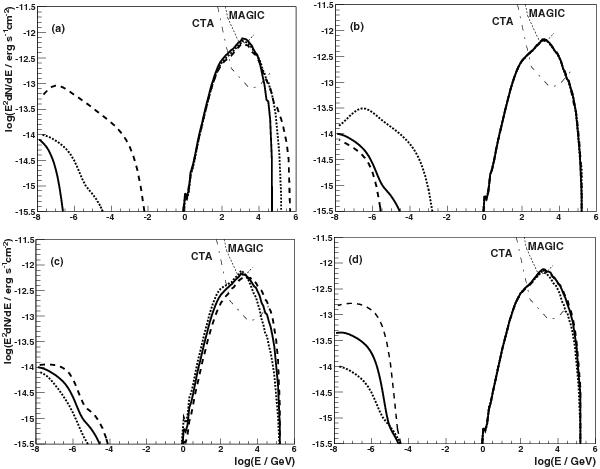Fig. 2

Gamma-ray (IC) and X-ray (synchrotron) spectra (spectral energy distribution – SED) produced in the nebula around the Black Widow binary system containing the millisecond pulsar B1957+20 for different model parameters. The spectra are produced by relativistic electrons which scatter the MBR and the infrared photons from the galactic disk. The maximum energies of the electrons are given by Eq. (4) and the minimum energies are equal to Ew = 3 TeV. a) Dependence of SED on the magnetization parameter σ = 0.1 (dashed), 0.01 (dotted), and 0.001 (solid) for the pulsar wind shock radius Rsh = 1016 cm, the power law spectrum of the electrons with spectral index α = 2.5 and the minimum magnetic field strength Bmin = 0.5 μG. b) Dependence of SED on the radius of the pulsar wind shock Rsh = 1015 cm (dotted), 1016 cm (solid), and 1017 cm (dashed), for σ = 0.01, α = 2.5, and Bmin = 0.5 μG. c) Dependence of SED on the spectral index of the electrons α = 2.1 (dashed), 2.5 (solid), and 3 (dotted) for Rsh = 1016 cm, σ = 0.01 and Bmin = 0.5 μG. d) Dependence of SED on the minimum value of the magnetic field Bmin = 0.5 μG (dotted), 1 μG (solid), and 2 μG (dashed) for Rsh = 1016 cm, σ = 0.01, and α = 2.5. It is assumed that the relativistic electrons take 10% of the rotational energy lost by the pulsar. The 100 h differential sensitivity of the MAGIC stereo system (thin dotted, Aleksic et al. 2012) and the 100 h CTA sensitivity (Actis et al. 2011) are also marked.
Current usage metrics show cumulative count of Article Views (full-text article views including HTML views, PDF and ePub downloads, according to the available data) and Abstracts Views on Vision4Press platform.
Data correspond to usage on the plateform after 2015. The current usage metrics is available 48-96 hours after online publication and is updated daily on week days.
Initial download of the metrics may take a while.






